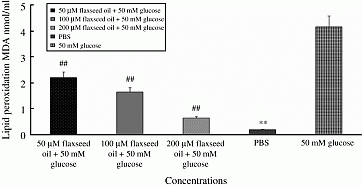ICEECE2012 Poster Presentations Diabetes (248 abstracts)
Effects of flaxseed oil on anti-oxidative system and membrane deformation of human erythrocytes in high glucose level
W. Yang
Public health, Wuhan, China.
Aim: The erythrocyte membrane lesion is a serious diabetic complication. Although most available data demonstrated by earlier studies that n-3 fatty acid was a potent agent in this complication of diabetes. Realization about protection effects of flaxseed oil on antioxidative capacity and against to membrane deformation of human peripheral blood erythrocytes in high glucose model is limited.
Main methods: In this study, erythrocytes were treated with 50 mM glucose to mimic hyperglycemia in the presence or absence of three doses of flaxseed oil (50, 100 and 200 μM) in the medium at 37 °C for 24 h. The malondialdehyde and L-glutathione were checked by HPLC and LC/MS respectively. The phospholipids symmetry and membrane fatty acid composition of erythrocytes were demonstrated by flow cytometer and gas chromatograph (GC). The morphology of erythrocyte was illuminated by ultra scanning electron microscopy.
Key findings: Our results illustrated that the flaxseed oil could prevent lipid peroxidation and delay the antioxidant capacity decreasing in erythrocytes. Also, the results of GC demonstrated that flaxseed oil groups contained higher C22:5 and C22:6 than 50 mM glucose group. These data indicated that flaxseed oil could reduce lipid asymmetric distribution and membrane perturbation.
Significance: This study provides new insights that the flaxseed oil supplementation may prevent the lipid peroxidation and membrane dysfunction of erythrocytes in diabetes.
| 50 μM flaxseed oil +50 mM glucose | 100 μM flaxseed oil +50 mM glucose | 200 μM flaxseed oil +50 mM glucose | glucose group (50 mM) | PBS (0.01 M) | |
| C14:0 (Myristic acid) | 2.90±0.3* | 3.70±0.5** | 4.20±0.7** | 1.90±0.2 | 6.80±0.4## |
| C16:0 (Palmitic acid) | 36.44±1.8* | 27.25±2.9** | 24.22±1.9** | 38.10±2.7 | 19.70±2.2## |
| C17:0 (Internal standard) | 0.61±0.1 | 0.62±0.2 | 0.67±0.1 | 0.62±0.1 | 0.64±0.2 |
| C18:0 (Stearic acid) | 17.16±3.0* | 14.81±3.0** | 10. 44±3.3** | 21.30±3.9 | 5.50±1.7## |
| C18:1 (Vaccenic acid) | 21.11±2.2* | 19.01±4.1** | 16.71±2.9** | 24.40±2.4 | 14.40±0.9## |
| C18:2 (Linoleic acid) | 2.20±0.3* | 4.90±0.6** | 6.30±0.8** | 1.40±0.2 | 9.60±0.5## |
| C22:0 (Behenic acid) | 0.97±0.2* | 1.29±0.2** | 2.00±0.4** | 0.90±0.1 | 3.90±0.3## |
| C22:5 (Docosapentaenoic acid) | 0.77±0.2* | 1.40±0.3** | 1.90±0.3** | 0.70±0.1 | 2.80±0.2## |
| C22:6 (Docosadienoic acid) | 0.79±0.1* | 1.10±0.1** | 2.10±0.1** | 0.60±0.1 | 3.20±0.6## |
| RBC fatty acids total concentration (pmol/mg Hb) | 18.29±1.4* | 20.10±2.2** | 27.89±2.7** | 17.04±2.5 | 32.33±3.1## |
| Note: Three concentrations of flax seed oil effect on fatty acid composition of membrane. *: P<0.05, ** and ##: P<0.01 are significantly different from 50 mM glucose group. (n=24) | |||||

Figure 1 demonstrated flaxseed oil reduced MDA level in erythrocytes. The MDA level in three concentrations of flaxseed oil and PBS groups were remarkably lower than glucose group. The ## and ** were significant difference from 50 mM glucose group (n=24, P<0.01).
Declaration of interest: The authors declare that there is no conflict of interest that could be perceived as prejudicing the impartiality of the research project.
Funding: This work was supported, however funding details unavailable.




